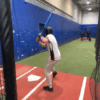Catchers are some of the toughest athletes in all of sports and the dangers of the position only seem to be increasing. Catcher’s are creeping closer and closer to the batter to increase their chances of framing low strikes, but it resulted in 94 catcher’s interference calls in 2023, an uptick from 74 in 2022. Compare that even further by looking back to 2002 when there were only nine!
This trend prompted Major League Baseball to issue a memo throughout the league prior to Opening Day this year encouraging teams to move catchers farther behind the plate to minimize risk. An incident less than 48 hours ago however, further indicates that the memo was surely filed in the garbage can with teams continuing to focus on results over safety.
Tuesday night St. Louis’ Catcher Willson Contreras crouched behind the dish to receive a 2-1 pitch to the Mets’ J.D. Martinez. In receiving the pitch, he was struck by J.D.’s bat resulting in a fractured forearm and 6-8 weeks on the IR.

The play wasn’t anything out of the regular. It was a breaking ball on the outside corner. Pitch tracker had it well within the strike zone at 85mph. So it’s not as if Contreras was diving at an odd pitch that Martinez was also flailing in an abnormal manner to reach. The incident was simply a result of setting up too close to the batter.
I am not an instructor at BASE by Pros, but rather work behind the scenes on marketing and other tasks. So I’m not here to offer advice on catching technique. I did play men’s league hardball well into my thirties though and spent a good deal of my years behind the dish, so I do find this trend interesting.
Now in my fifties, I’ve always been well aware that philosophies regarding mechanics change over time. I have tried to keep an open mind, but I’ll admit I do occassionally struggle to wrap my head around certain concepts that are simply common practice now. One example is right here in front of us, catching in a relaxed position on one leg. When I first joined BASE by Pros in 2017 I was shocked to see how common this was becoming. I didn’t lose sleep over it though because it seemed it was only being used when the bases were empty. It’s becoming more and more commonplace though with today’s elite catchers arguing that they don’t lose mobility and can still get off a quick throw. I always assumed it was about a catcher maintaining their knees into old age, but have come to learn that there’s more to it than that as it also better positions catchers to receive pitches low in the zone.
So I get it. There’s more and more of an emphasis these days on getting those low calls. How far are we willing to go though? How much danger are we willing to put our catchers in?
The MLB has stats for everything and are putting those to work to push the limits as far as possible. Catchers know that when Oakland’s Esteury Ruiz or Houston’s Kyle Tucker step in the box, they should give a little ground as those two each led the league drawing seven catcher interference calls last year.
Those stats aren’t as widely available at the lower levels though, so then what? Are wrist and forearm guards for catchers the next big thing? Do we even want to risk hits to the back of the head?
The Contreras incident will surely throw more fuel on the fire for those looking to replace home plate umps with pitch tracking technology. Many believe the technology isn’t quite there yet though.
Another solution is to add a chalk line for catchers to set up behind. Two challenges I see to that however are that the line would continually erase and it would make life extra challenging against batters who move up in the box. As a baseball fan though, I love the idea. With more balls up in the zone, offense would be through the roof and more balls in the dirt would surely liven up the basepaths!
Following the game, Contreras had this to say, “There’s always a risk being a catcher. Could have been something different. It could’ve been off my knee, it could be a concussion. That risk is always going to be there. I’m not blaming any part of my game because this happened tonight. When I get back, I’m going to try to be the same guy behind the plate.”
So I don’t know what the answer is, but based on his statement, maybe looking for answers is a bit of an overreaction. What I do know is that this was the 33rd catchers interference of the season so far and we’re barely into May.
Catchers are setting up closer and closer to the plate to help pitchers get strikes. At the same time, batters are looking to quickly move their bat on plane with the catcher’s mitt and they’re often letting the ball travel further in the zone as well. It’s a recipe for more injuries and the catcher’s aren’t the only ones who feel the sting. Via the Associated Press Martinez summed up where his head was at saying, “I hit meat. I felt like I hit meat. I didn’t hit like just like a glove where you kind of just point back to catcher, it was just solid. I was like, dude, I hit him good. … I felt terrible.”
Of course, batters do have one simple solution in their back pocket. When catchers gets too close, they could always hit the mitt on a check swing. No, no, no, I do not advocate this. But, you know, a nice, gentle tap maybe?
BASE by Pros Catching Instructor Bryce Cote offers this final thought, “The thing about being a catcher today is they are put into strange positions, beyond trying to get as low as you can and still be athletic to get under pitches and beat the ball to a spot. Now you have to present the ball for an umpire so they can do they’re job while not giving hitters a free 90. Catcher’s interference is not something that gets talked about a lot but umpires missing calls gets talked about almost every other pitch. At the end of the day it comes down to comfortability and preference. Can I set up here and do my job? Yes? Perfect then I’m here, I think that’s all you ask about the catchers at this point.”







